ikfoundation.org
Promoting Natural & Cultural History
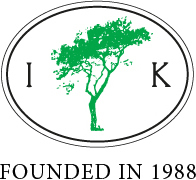


ESSAYS |
DOUBLE INTERLOCKED TAPESTRIES
in Works of Art
Long-lasting traditions, the usefulness of the textiles and the creation of large dowries were the three most important factors in the increasing production of “rölakan” or double interlocked tapestries – as with many other woven techniques and embroideries – in southernmost Sweden during the period 1700 to 1850s. In this part of the series of these decorative textiles, I will primarily describe the basic functions and their extended history in time and place through artworks and the museum’s interior displays.
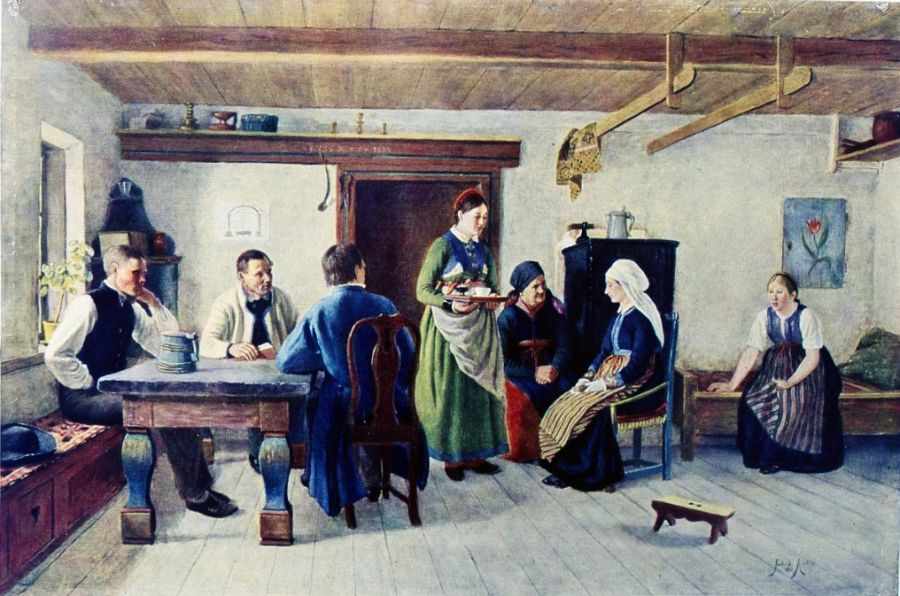 It was not accidental that Jakob Kulle’s interior paintings from farmer’s home depicted detailed textiles to such an extent, he and his sister-in-law Thora Kulle were both deeply involved in the early attempts to save the traditions of the long-lived textile handicraft during the later decades of the 19th century. This oil on canvas showing a Sunday morning from a farmer’s home in Torne district, Skåne c. 1870s. (Cederblom, G., Svenska folklivsbilder, fig 85, 1923).
It was not accidental that Jakob Kulle’s interior paintings from farmer’s home depicted detailed textiles to such an extent, he and his sister-in-law Thora Kulle were both deeply involved in the early attempts to save the traditions of the long-lived textile handicraft during the later decades of the 19th century. This oil on canvas showing a Sunday morning from a farmer’s home in Torne district, Skåne c. 1870s. (Cederblom, G., Svenska folklivsbilder, fig 85, 1923).The interior decoration in the farmers’ dwelling houses in Skåne consisted of a limited number of useful furniture, which were commonly placed along the walls of the main room. The strict confinement with furnishing along the walls and free space at the centre descended from an older epoch when the hearth was centred in the room.
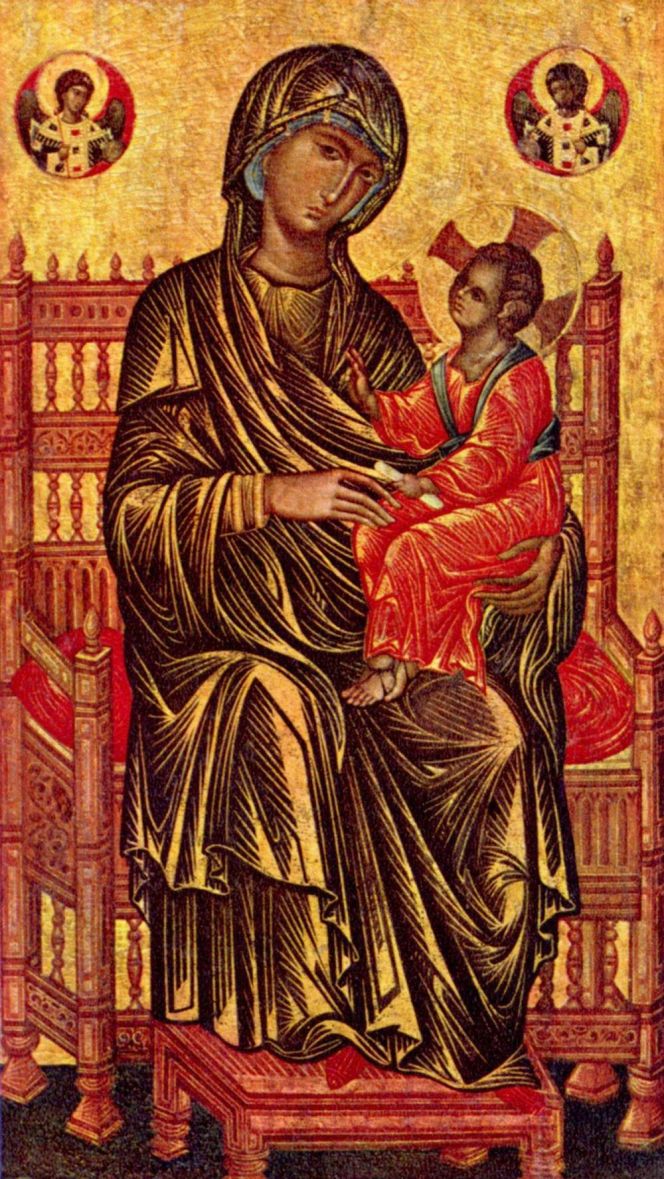 Example of 13th century artwork on wood panel, with madonna sitting on a cushion. Unknown Italian-Byzantine painter. (Owner: National Gallery of Art, Washington D.C., USA. Wikimedia Commons).
Example of 13th century artwork on wood panel, with madonna sitting on a cushion. Unknown Italian-Byzantine painter. (Owner: National Gallery of Art, Washington D.C., USA. Wikimedia Commons).Being comfortably seated before the tradition of upholstered furniture, portable cushions and pads fulfilled this function. Providing practical places to sit was, of course, not a new phenomenon during the 18th century, but when the seat cushion had its true origin is unknown. However, the evidence for the use of seat cushions has a long history, which foremost can be studied in older illustrations and works of art where pads are visible together with a portrayed person. Most probably, the seating tradition was introduced with the sack-shaped cushion. This type can already be seen on mural depictions in the catacombs of Rome and was later often present in artworks of various forms during the period from the 9th- to early 16th centuries, principally within churches' interior decorations and as illustrations in handwritten books. The four-sided cushion has a parallel tradition from the 10th century, while bench cushions were the first possible study in Renaissance art. In these well-to-do homes, decorations and religious motives, which are reflected in the described art objects from the Byzantine Empire, Rome, and further north in Europe, the usage of portable cushions ended around the time of the Renaissance’s final phase. Furnishing along the walls now more and more is replaced with the developing tradition of moveable furniture and upholstered chairs which were followed by divans and sofas in coming centuries. Even so, in “ordinary homes”, the older furnishing tradition stayed on for much longer in many places, for example, with the farmers from Skåne, where the portable cushions in various sizes were commonly in use up to the mid-19th century.
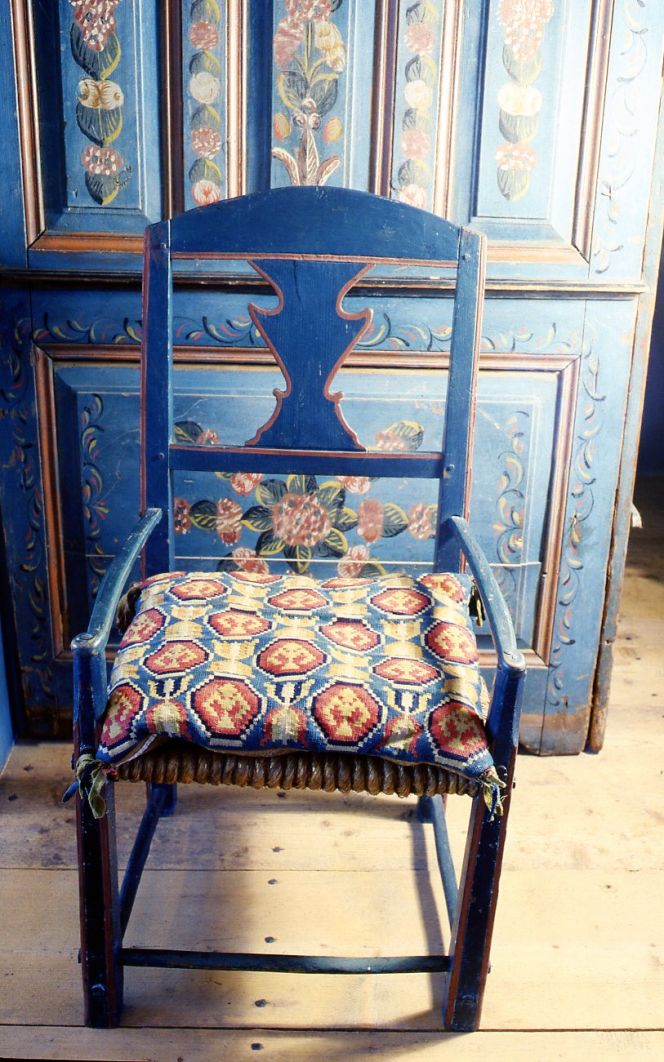 Chair with square sized cushion woven in double interlocked tapestry from Villands district, Skåne. (Owner and museum interior: Malmö museums, photo: The IK Foundation, London).
Chair with square sized cushion woven in double interlocked tapestry from Villands district, Skåne. (Owner and museum interior: Malmö museums, photo: The IK Foundation, London).From the researched material of more than 1.600 double interlocked tapestries – as described in earlier essays – four areas of use have been possible to detect. These were: seat cushion 28 %, travel cushion 42%, bench cushion 14%, and bedcover 13 % added with a smaller number of textile fragments/cut pieces of fabric with uncertain original usage. The large number of travel cushions from the documentation work was not only used in the carriage but could also function as a seating cushion indoors for two people.
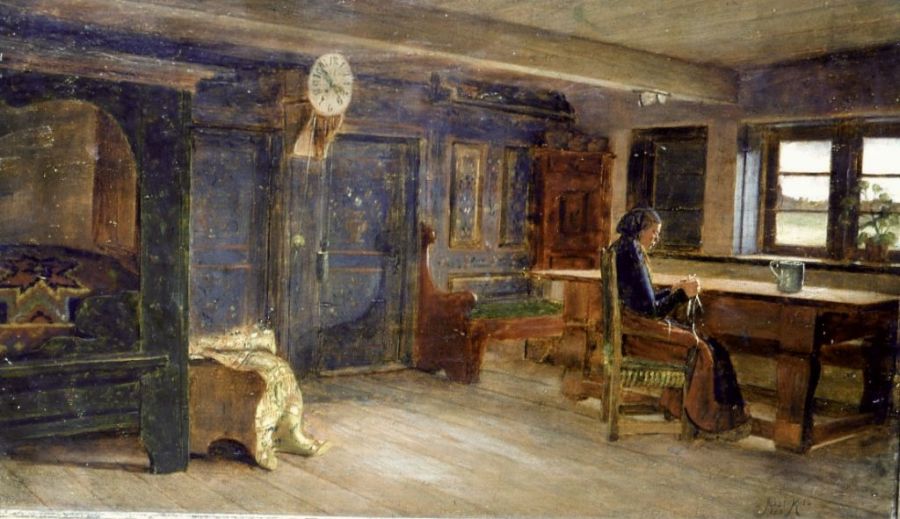 Farmhouse interior in southern Skåne. Notice the bed, covered by a double interlocked tapestry with star motifs. Oil on canvas by Jakob Kulle, 1881 (Owner: Malmö museums, photo: The IK Foundation, London).
Farmhouse interior in southern Skåne. Notice the bed, covered by a double interlocked tapestry with star motifs. Oil on canvas by Jakob Kulle, 1881 (Owner: Malmö museums, photo: The IK Foundation, London).It must be noted that the majority of the woven textiles during the main part of the year were kept in chests. The number of textiles in wealthy farmers’ homes was also usually extensive, which often led to a need for separate chambers intended for the chests where woven fabrics and other valuable items could have safe protection. To keep one’s treasured possessions in chests, was like so many other customs in the homes of the farmers inherited from the upper classes furnishing. The tradition reaches far back to the Viking Age and early Medieval period, from when chests were located from these groups of society. The chests for the gentry, as well as the burghers, vicarages, etc, also continued to be the primary place for keeping the family’s personal belongings up to the early 18th century, when the chest gradually was replaced with storage in cupboards and clothes closets. On the other hand, by many “ordinary citizens” like from the south Swedish farmers’ homes, the chest kept its popularity as the most essential piece of furniture for storage more than 100 years longer, up to the mid-19th century.
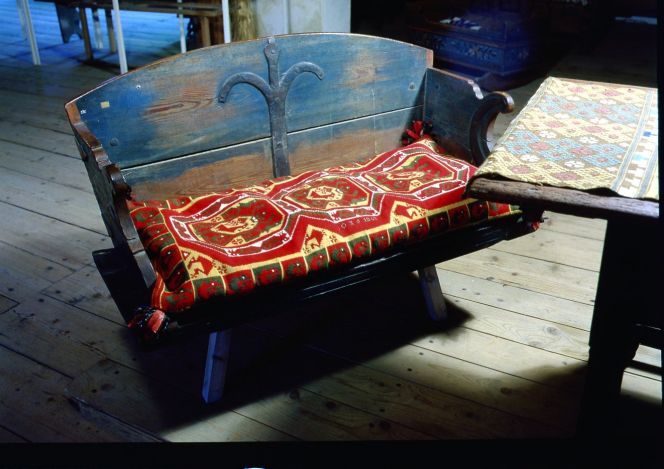 Carriage seat with travel cushion from south eastern Skåne. (Owner and interior: Österlen museum, Simrishamn, photo: The IK Foundation, London).
Carriage seat with travel cushion from south eastern Skåne. (Owner and interior: Österlen museum, Simrishamn, photo: The IK Foundation, London).At festivities, the textiles adorned the farmer’s interiors in abundance, and one preferred to use several travel cushions on top of each other on the way to church to show off the status of the family. Nevertheless, in everyday life, the homes were quite sparsely decorated, consisting most commonly of bed linen, feather beds, sometimes a seat cushion and simple striped bench covers. Festivities and celebrations of various kinds could be several during the year. Still, when a wedding took place this was one of the more important occasions in a family’s life. This event had been prepared during several years of collecting, weaving and embroidering for the daughter’s dowry. Consisting of woven fabrics, clothes, bed linen and embroideries, often double interlocked tapestries were included as treasured possessions which not only had an economic value and gave the family a particular status for the moment. These textiles also had considerable value in the long term and became possible to inherit through several generations, for the reason that said textile belongings most of the time were kept in chests, were given an airing but otherwise kept out of the sunlight. The consideration of one’s interior decorative textiles contributed in other words, towards limited wear and tear; the colours of the wool were almost preserved unchanged through the years and at the same time as the storage of many farmers’ textiles had the possibility to be added in size for each coming generation.
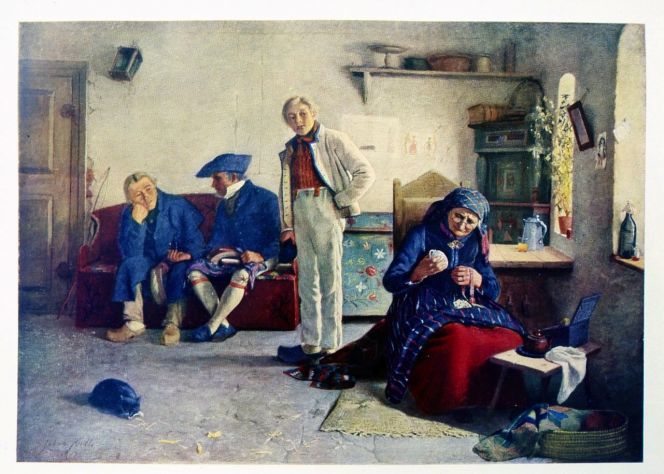 The artist Jakob Kulle at several occasions also used the decorative textiles from Skåne as pure “display” in his interior paintings. Here demonstrated with a double interlocked tapestry piece with star motif placed in the basket at the front. Torna district, Skåne c. 1870s. (Cederblom, G., Svenska folklivsbilder, fig 88, 1923).
The artist Jakob Kulle at several occasions also used the decorative textiles from Skåne as pure “display” in his interior paintings. Here demonstrated with a double interlocked tapestry piece with star motif placed in the basket at the front. Torna district, Skåne c. 1870s. (Cederblom, G., Svenska folklivsbilder, fig 88, 1923). A farmer’s family from Torna district in Skåne; consider the extent of the daughter’s dowry, with the lid of the chest open. Oil on canvas by Jakob Kulle , 1876. (Cederblom, G…, fig 84, 1923).
A farmer’s family from Torna district in Skåne; consider the extent of the daughter’s dowry, with the lid of the chest open. Oil on canvas by Jakob Kulle , 1876. (Cederblom, G…, fig 84, 1923).Sources:
- Cederblom, Gerda, Svenska folklivsbilder, Stockholm 1923.
- Hansen, Viveka, Textila Kuber och Blixtar – Rölakanets Konst- och Kulturhistoria, Christinehof 1992 (pp. 141-58).
- Hansen, Viveka, Swedish Textile Art, London 1996.
Essays
The iTEXTILIS is a division of The IK Workshop Society - a global and unique forum for all those interested in Natural & Cultural History from a Textile Perspective.
Open Access essays - under a Creative Commons license and free for everyone to read - by Textile historian Viveka Hansen aiming to combine her current research and printed monographs with previous projects dating back to the late 1980s. Some essays also include unique archive material originally published in other languages, made available for the first time in English, opening up historical studies previously little known outside the north European countries. Together with other branches of her work; considering textile trade, material culture, cloth manufacturing, fashion, natural dyeing and the fascinating world of early travelling naturalists – like the "Linnaean network" – from a Global history perspective.
For regular updates, and to make full use of iTEXTILIS' possibilities, we recommend fellowship by subscribing to our monthly newsletter iMESSENGER.
been copied to your clipboard




– a truly European organisation since 1988
Legal issues | Forget me | and much more...
It is free to use the information/knowledge in The IK Workshop Society so long as you follow a few rules.
 LEARN MORE
LEARN MORE








